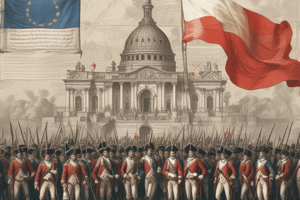Podcast
Questions and Answers
¿Cuál de las siguientes constituciones mantuvo la monarquía pero transfirió la soberanía a la Asamblea Legislativa?
¿Cuál de las siguientes constituciones mantuvo la monarquía pero transfirió la soberanía a la Asamblea Legislativa?
- Constitución de 1799
- Constitución de 1795
- Constitución de 1791 (correct)
- Constitución de 1793
¿Cuál de las siguientes constituciones estableció la Primera República Francesa al abolir la monarquía?
¿Cuál de las siguientes constituciones estableció la Primera República Francesa al abolir la monarquía?
- Constitución de 1795
- Constitución de 1791
- Constitución de 1793 (correct)
- Constitución de 1799
¿Qué tipo de ciudadanos tenían derecho a votar en la Constitución de 1791?
¿Qué tipo de ciudadanos tenían derecho a votar en la Constitución de 1791?
- Los ciudadanos activos que pagaban una suma mínima en impuestos (correct)
- Los ciudadanos que no pagaban impuestos
- Todos los ciudadanos adultos
- Solo los nobles
¿Qué constitución resultó en el establecimiento del 'Reinado del Terror' debido a la continua agitación social y política?
¿Qué constitución resultó en el establecimiento del 'Reinado del Terror' debido a la continua agitación social y política?
¿Cuál fue una característica única de la Constitución de 1793 en comparación con la de 1791?
¿Cuál fue una característica única de la Constitución de 1793 en comparación con la de 1791?
¿Por qué la Constitución de 1791 tuvo una duración inferior a un año?
¿Por qué la Constitución de 1791 tuvo una duración inferior a un año?
¿Qué tipo de república estableció la Constitución de 1795 (Año III)?
¿Qué tipo de república estableció la Constitución de 1795 (Año III)?
¿Qué función tenía el Directorio según la Constitución de 1795?
¿Qué función tenía el Directorio según la Constitución de 1795?
¿Cuál fue el impacto principal de la Constitución de 1799 en Francia?
¿Cuál fue el impacto principal de la Constitución de 1799 en Francia?
¿Cuál era el papel del Consulado según la Constitución de 1799?
¿Cuál era el papel del Consulado según la Constitución de 1799?
¿Qué poder se concentraba principalmente en el ramo ejecutivo según la Constitución de 1799?
¿Qué poder se concentraba principalmente en el ramo ejecutivo según la Constitución de 1799?
¿Cuál fue uno de los desafíos destacados al establecer un gobierno efectivo durante la Revolución Francesa?
¿Cuál fue uno de los desafíos destacados al establecer un gobierno efectivo durante la Revolución Francesa?
Flashcards are hidden until you start studying
Study Notes
French Constitutions of 1791, 1793, 1795, 1799
The French Revolution marked a pivotal moment in history, leading to significant political reforms and the establishment of new constitutions. Over the course of the revolution, four constitutions were created, each with its own unique characteristics and implications.
Constitution of 1791
The first constitution, known as the Constitution of 1791, was established by the National Assembly during the French Revolution. This constitution retained the monarchy but transferred the sovereignty to the Legislative Assembly. The franchise was restricted to "active" citizens who paid a minimal sum in taxes, allowing about two-thirds of adult men to vote for electors and choose certain local officials directly. Despite its relatively liberal framework, this constitution lasted less than a year due to the social and political upheaval that characterized the French Revolution.
Constitution of 1793
The second constitution, adopted in 1793, was more radical and democratic. It abolished the monarchy and established the First French Republic. This constitution granted citizens the right to vote for all members of the legislature, further expanding the franchise. However, the social and political unrest continued, leading to the establishment of the Reign of Terror, a period of extreme violence and repression.
Constitution of 1795 (Year III)
In 1795, during the Thermidorian Reaction, a more conservative constitution, known as the Constitution of 1795 (Year III), was established. This constitution created a liberal republic with a franchise based on the payment of taxes, similar to that of the 1791 constitution. It also established a bicameral legislature and a five-man Directory to slow down the legislative process. While it maintained many of the democratic elements of the previous constitutions, it also granted the central government significant emergency powers to curb freedom of the press and association.
Constitution of 1799
The final constitution, adopted in 1799, marked the end of the French Revolution and the beginning of the Napoleonic era. Established by Napoleon Bonaparte, this constitution established the Consulate, a period of political stability and centralization. It granted citizens the right to vote for all members of the legislature, but the political power was concentrated in the hands of the executive branch, which was headed by Napoleon.
These constitutions reflect the tumultuous and transformative nature of the French Revolution, as the country transitioned from a monarchy to a republic and back again, with varying degrees of democratic representation and centralization. They also highlight the challenges of establishing a stable and effective government in the midst of social and political upheaval.
Studying That Suits You
Use AI to generate personalized quizzes and flashcards to suit your learning preferences.



